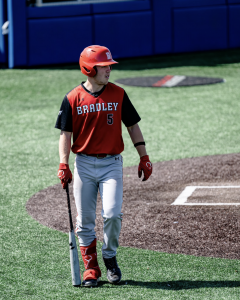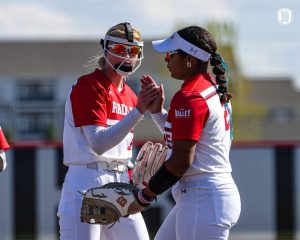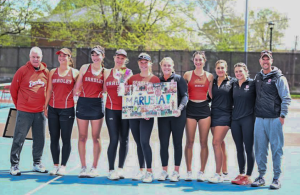
The Missouri Valley Conference will have a different look to it in just a few months.
After Illinois-Chicago officially announced its plans to join the third-oldest conference in the nation on Jan. 26, the last piece of the puzzle had been placed. For the first time in its history, the Valley will have 12 full members after Murray State and Belmont stand ready for the MVC gates to open when the 2022-23 academic year commences on July 1.
Loyola-Chicago, an MVC member since 2013, decided to forgo its potential decade-long stay following its November announcement to join the Atlantic 10 Conference this coming July.
Texas-Arlington, Kansas City, Omaha and Northern Kentucky were all rumored at one point or another to be potential candidates to expand the Valley. UTA found a home in the Western Athletic Conference and there are currently no substantial rumors for the other three schools to alter their affiliations.
So now that the dust has settled, the soda has stopped fizzing and the winds of conference change are quiet — at least for now — let’s look at who benefits and who doesn’t from the MVC’s changes.
WINNERS: Murray State and Belmont
We’ll start with the most obvious decision. The Racers and Bruins have been members of the Ohio Valley Conference and were the MVC’s biggest targets for acquisition. Pulling off the move to wrangle Murray St. into the Valley was particularly impressive since the Racers were charter members of the OVC since the conference’s inception in 1948.
Both basketball programs have had no shortage of success and March Madness bids in the last decade. Most remember Murray St. for being one of the premier mid-major teams in 2018 and 2019 when Memphis Grizzlies guard and NBA All-Star Ja Morant was running the show. At the time of this publication, the Racers are 21-2 this season and ranked No. 27 in the NCAA’s NET rankings, higher than any Missouri Valley team.
Belmont has gone dancing eight times (all since 2006) and boasts a 126-33 record in the last five full seasons. Two successful role players in the NBA, Ian Clark and Dylan Windler, have passed through the Bruins’ program in the last decade as well.
The OVC is typically a one-bid league in basketball, so it wouldn’t be fair for either program to stay in “the other Valley” much longer. Adding Murray State and Belmont should make the MVC a perennial multi-bid league.
LOSER: Loyola-Chicago
Belmont’s September announcement of joining the MVC wasn’t enough to keep the Ramblers in potentially their best-suited conference geographically. After a Cinderella run to the Final Four in 2018 and a Sweet Sixteen trip in 2021, Loyola believed it made sense to jump to the Atlantic 10, home of Davidson, Dayton and St. Bonaventure, most notably.
The Ramblers have packed a punch in the MVC for the last few years but have only reached the NCAA Tournament one other time since Neil Armstrong and Buzz Aldrin landed on the moon. The Atlantic 10 regularly puts more than one team in the Big Dance, but it’s more than reasonable to think the MVC will now do the same.
Loyola has one of the most experienced teams in the nation and will lose starters Lucas Williamson and Aher Uguak along with key bench pieces in Ryan Schwieger, Chris Knight, Keith Clemons and Tate Hall all to graduation. That’s over 55% of their scoring, two outstanding defenders and the last remaining players who were a part of both of the Ramblers’ recent NCAA bids.
Loyola has reasons to stay optimistic in Braden Norris and Marquise Kennedy returning and an up-and-coming head coach in Drew Valentine, who can recruit at a high level. However, staying in the Valley rather than making a seeming half-step up to the Atlantic 10 would have launched the MVC’s national respect into the stratosphere.
Shame on you, Loyola.
WINNER: MVC athletic departments
The front offices of MVC schools likely breathed a sigh of relief when the rumors of Texas-Arlington and Kansas City joining the conference stalled. Rather than traveling hundreds of miles down to Texas and having travel expenses shoot up, teams (and their corresponding athletic departments) won’t have to spend as much to travel to the Ohio River valley.
Evansville and Southern Illinois were relatively isolated from most of the conference geographically. However, Murray State, located in western Kentucky, and Belmont in Nashville provide opportunities for shorter travel distances and potential future rivalries between the southern contingent of the MVC. Sure, Des Moines to Nashville isn’t the most desirable bus trip, but it sure beats Loyola having to travel to Philadelphia.
As mentioned earlier, the heightened possibility of the MVC receiving multiple bids to the NCAA Tournament will result in more money allocated to the conference, which can eventually trickle down to member schools’ front offices.
LOSER: Conference tournament format
Consistently one of the most intriguing men’s basketball tournaments in the country, Arch Madness (and Hoops in the Heartland for women’s basketball) is all but certain to look a lot different.
Every MVC school wants to avoid the dreaded first-round games on Thursday, reserved for the bottom four teams in the conference standings. Now with 12 teams, it’s safe to say the MVC will likely have the top four teams receive byes to Friday and the remaining eight teams play their first games on Thursday.
The addition of Thursday games will make it harder for a 5-seed or lower to win Sunday’s championship game since they would play four games in four days. Valparaiso was the first team to do so when it faced off against Bradley for the MVC championship in 2020. Astute Braves fans will remember that Valpo looked plain exhausted as Bradley won by double-digits. Seeing underdogs and teams that aren’t physically exhausted play on Sunday in St. Louis now may not happen at all now.
WINNER: Luke Yaklich (and the rest of Chicago)
Illinois-Chicago is easily the “ugly sibling,” if I had to name one, among the MVC newcomers. The Flames have hung around the bottom half of the Horizon League for recent memory, but head coach Luke Yaklich gives them a reason for optimism.
Yaklich began coaching in 1999, heading Illinois high schools such as Sterling, LaSalle-Peru and Joliet West. He then went on to fill assistant roles at Illinois State, Michigan and Texas before taking over UIC last season. While the Flames haven’t been extremely impressive this season, Yaklich is a defensive mastermind, leading Michigan to the second-ranked defense in the country in 2018, and he has become well-respected in just his second year in the Windy City.
Adding UIC also allows the Valley to retain the Chicago media market. Nobody is going to be upset about the possibility of playing a game on the NBC Sports Chicago network. The Flames will also be able to rekindle their Horizon League rivalry with Valparaiso just across the Indiana border.
Lest we forget, Loyola was also not exactly a conference title contender when they joined the MVC in 2013. They additionally didn’t have the majority share of the Chicago college basketball fanbase, but the Ramblers turned their mediocre fortunes into something special. There’s too many similarities here to think Illinois-Chicago can’t do the same.




